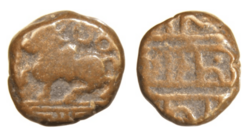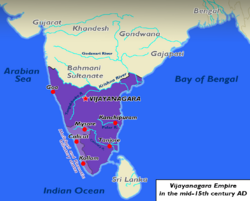Deva Raya II facts for kids
Quick facts for kids Deva Raya II |
|
|---|---|

bronze Pagoda of Deva Raya II
|
|
| Emperor of Vijayanagara | |
| Reign | 10 February 1423 – 24 May 1446 |
| Predecessor | Bukka Raya III |
| Successor | Deva Raya III |
| Born | Vijayanagara, Vijayanagara Empire (modern day Hampi, Karnataka, India) |
| Died | 24 May 1446 Vijayanagara, Vijayanagara Empire (modern-day Hampi, Karnataka, India) |
| Issue | Deva Raya III |
| House | Sangama |
| Father | Bukka Raya III |
| Mother | unknown |
| Religion | Hinduism |
Deva Raya II was a powerful emperor of the Vijayanagara Empire who ruled from 1423 to 1446. Many people believe he was the greatest ruler of the Sangama dynasty. He was a skilled leader, a brave warrior, and a smart scholar. He wrote famous books in Kannada and Sanskrit. He also supported many talented poets and writers of his time. These included Kannada poets like Chamarasa and Kumara Vyasa, and the famous Telugu language poet Srinatha. Srinatha was even given the special title Kavisarvabhauma, which means "Emperor of poets." Deva Raya II also supported scientists, like the mathematician Parameshvara.
Historians say Deva Raya II had the title Gajabeteegara, meaning "Hunter of elephants." This might have meant he loved hunting elephants, or it could have been a way to say he was very strong and defeated enemies who were as powerful as elephants. Even with some challenges, Deva Raya II expanded his empire and kept control of lands up to the Krishna River. According to a visitor named Abdur Razzak, Deva Raya II's empire stretched from Ceylon (modern-day Sri Lanka) to Gulbarga, and from Orissa to the Malabar Coast. He even had a fleet of ships to help with trade and connections overseas. Another explorer, Nicolo Conti, noted that the king collected taxes from places like Ceylon, Quilon, Pegu, Pulicat, and Tenasserim.
Contents
A Golden Age for the Empire
Expanding and Protecting the Empire
Deva Raya II's rule was a very important time for South India, especially for the region of Karnataka. He became emperor after his father, Veera Vijaya Bukka Raya, who ruled for only two years. Even before he became king, around 1423, Deva Raya II had already won battles against the Bahamani Sultanate. He even forced them to move their capital city in 1426.
Deva Raya II fought three important battles against the Gajapati Kingdom of Odisha. He won a battle in 1427 and fought again in 1436 and 1441. He also stopped an invasion by the Reddis of Kondavidu. By 1432, he had brought all the smaller rulers in the region under the control of the Vijayanagara Empire.
Challenges with Neighboring Kingdoms
After a short time of peace, the Vijayanagara Empire went to war again with their old rivals, the Bahamani Sultanate. These wars had mixed results. Around 1436, a new Bahamani ruler, Ala-ud-din II, demanded tribute from Deva Raya II. Some accounts say Deva Raya II had to pay a large amount to keep the peace. During this time, the Vijayanagara armies faced difficulties. This led Deva Raya II to include many skilled Muslim soldiers in his army to make it stronger.
Around 1443, during a confusing time when an attempt was made on the king's life, some areas near the Tungabhadra River and Krishna River were lost to the Bahamani Sultanate. There are different stories about what caused these wars. One story says Deva Raya II refused to pay tribute he had agreed to earlier. Another story says the Bahamani Sultan tried to take advantage of the confusion after the attempt on Deva Raya II's life. The Sultan demanded a huge payment, which Deva Raya II refused, leading to war. In the first battles, Vijayanagara armies were successful, capturing some important forts. However, in later battles, the Vijayanagara armies were pushed back.
Success in the South and Beyond
Deva Raya II's empire also included Kerala. He defeated the ruler of Quilon and other local leaders there. His skilled commander, Lakkanna, even invaded Ceylon (Sri Lanka) and brought back valuable tributes. The Zamorin of Calicut and even the kings of Burma in Pegu and Tanasserim paid tribute to Deva Raya II. This shows how powerful and respected he was.
What Foreign Visitors Saw
During Deva Raya II's reign, two important explorers visited South India: Nicolo Conti and Abdur Razzak. Conti wrote that "the king of Vijayanagar is more powerful than all the other kings in India." Razzak was amazed by the city of Vijayanagara, writing that "the ear of intelligence had never been informed that there existed anything equal to Vijayanagara in the world."
Razzaq, who was also an ambassador, wrote that the king had "three hundred ports," each as busy as Calicut. He also said that the empire was so large it would take three months to travel across it. Both travelers agreed that the country was full of towns and villages. Razzaq noted that "The country is for the most part well cultivated and very fertile." He also mentioned that the army had "eleven Lakhs (1,100,000)" soldiers. Razzaq thought Vijayanagara was one of the most amazing cities he had ever seen. He described it as having "seven citadels and the same number of walls" protecting each other. He also wrote about the busy markets where "jewelers sell publicly... pearls, rubies, emeralds and diamonds." In the king's palace, he saw "numerous running streams and canals formed of chiseled stone."
Culture and the Arts
Deva Raya II's rule was a fantastic time for the development of Kannada literature. There was a lot of friendly competition between writers from different religious groups. Some of the most famous Kannada writers of the 15th century, like Chamarasa and Kumara Vyasa, were part of his court. The king himself was also a writer, and two romantic stories, Sobagina Sone (meaning "The Drizzle of Beauty") and Amaruka, are believed to have been written by him.
In the Telugu language, this was the time of Srinatha. He was incredibly skilled in both Telugu and Sanskrit languages. He even won a debate against a famous Sanskrit scholar named Dindima. Srinatha was given the special title Kavisarvabhauma ("Emperor of poets"). The king showed his appreciation by showering Srinatha with gold coins in a special ceremony. Srinatha was known to live a life of luxury and was friends with the king's ministers.


